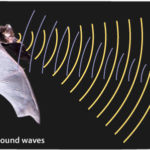Researcher uses bat-inspired design to develop new approach to sound location
Inspired by the workings of a bat’s ear, Rolf Mueller, a professor of mechanical engineering at Virginia Tech, has created bio-inspired technology that determines the location of a sound’s origin. Mueller’s development works from a simpler and more accurate model of sound location than previous approaches, which have traditionally been modeled after the human ear. His work marks the first new insight for determining sound location in 50 years. The findings were published in Nature Machine Intelligence by Mueller and a former Ph.D. student, lead author Xiaoyan Yin. “I have long admired bats for their uncanny ability to navigate complex natural environments based on ultrasound and suspected that the unusual mobility of the animal’s ears might have something to do with this,” said Mueller. A new model for sound location Bats navigate as they fly by using echolocation, determining how close an object is by continuously emitting sounds and listening to the echoes. Ultrasonic calls are emitted from the bat’s mouth or nose, bouncing off the elements of its environment and returning as an echo. They also gain information from ambient sounds. Comparing sounds to determine their origin is called the Doppler effect. The Doppler effect works differently in human ears. A 1907 discovery showed that humans can find location by virtue of having two ears, receivers that relay sound data to the brain for processing. Operating on two or more receivers makes it possible to tell the direction of sounds that contain only one frequency, and would be familiar to anyone who has heard the sound of a car horn as it passes. The horn is one frequency, and the ears work together with the brain to build a map of where the car is going. A 1967 discovery then showed that when the number of receivers is reduced down to one, a single human ear can find the location of sounds if different frequencies are encountered. In the case of the passing car, this might be the car horn paired with the roaring of the car’s engine. According to Mueller, the workings of the human ear have inspired past approaches to pinpointing sound location, which have used pressure receivers, such as microphones, paired with the ability to either collect multiple frequencies or use multiple receivers. Building on a career of research with bats, Mueller knew that their ears were much more versatile sound receivers than the human ear. This prompted his team to pursue the objective of a single frequency and a single receiver instead of multiple receivers or frequencies.
Learn about our two Decals!
 Click here to find out more about our Fall Bioinspired Design Decal and our Spring Bioinspired Design in Action Decal – ALL MAJORS are welcome.
Click here to find out more about our Fall Bioinspired Design Decal and our Spring Bioinspired Design in Action Decal – ALL MAJORS are welcome.Berkeley BioDesign Community
 Click here to learn about the BioD: Bio-Inspired Design @ Berkeley student organization or here to signup for more info.
Click here to learn about the BioD: Bio-Inspired Design @ Berkeley student organization or here to signup for more info.Search
Student Login




I imagine that the neurological circuits underlying these processes are governed by both 2d spacing maps with their brains as…
to reduce the impact of car accidents, it may be possible to study the force diverting physics of cockroaches to…
you see this type of head-bobbing stability in many avian creatures related to pigeons like chickens. the head ability to…
not like they taught horses how to run! this is an example of convergent evolution where both sea creatures and…
The brain functions in a similar way with neuronal connections. our brains are able to utilize the multiplicity of connections…